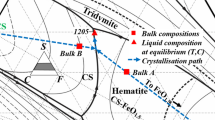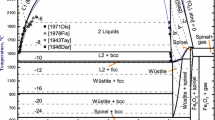Abstract
High-temperature oxide-melt calorimetry and Rietveld refinement of powder X-ray diffraction patterns were used to investigate the energetics and structure of the hematite–corundum solid solution and ternary phase FeAlO3 (with FeGaO3 structure). The mixing enthalpies in the solid solution can be described by a polynomial ΔHmix=WX hem(1−X hem) with W=116 ± 10 kJ mol−1. The excess mixing enthalpies are too positive to reproduce the experimental phase diagram, and excess entropies in the solid solution should be considered. The hematite–corundum solvus can be approximately reproduced by a symmetric, regular-like solution model with ΔG excess=(W H −TW S )X hem X cor, where W H= 116 ± 10 kJ mol−1 and W S =32 ± 4 J mol−1 K−1. In this model, short-range order (SRO) of Fe/Al is neglected because SRO probably becomes important only at intermediate compositions close to Fe:Al=1:1 but these compositions cannot be synthesized. The volume of mixing is positive for Al-hematite but almost ideal for Fe-corundum. Moreover, the degree of deviation from Vegard's law for Al-hematite depends on the history of the samples. Introduction of Al into the hematite structure causes varying distortion of the hexagonal network of oxygen ions while the position of the metal ions remains intact. Distortion of the hexagonal network of oxygen ions attains a minimum at the composition (Fe0.95Al0.05)2O3. The enthalpy of formation of FeAlO3 from oxides at 298 K is 27.9 ± 1.8 kJ mol−1. Its estimated standard entropy (including configurational entropy due to disorder of Fe/Al) is 98.9 J mol−1 K−1, giving the standard free energy of formation at 298 K from oxides and elements as +19.1 ± 1.8 and −1144.2 ± 2.0 kJ mol−1, respectively. The heat capacity of FeAlO3 is approximated as C p (T in K)= 175.8 − 0.002472T − (1.958 × 106)/T 2− 917.3/T 0.5+(7.546 × 10−6) T 2 between 298 and 1550 K, based on differential scanning calorimetric measurements. No ferrous iron was detected in FeAlO3 by Mössbauer spectroscopy. The ternary phase is entropy stabilized and is predicted to be stable above about 1730 ± 70 K, in good agreement with the experiment. Static lattice calculations show that the LiNbO3-, FeGaO3-, FeTiO3-, and disordered corundum-like FeAlO3 structures are less stable (in the order in which they are listed) than a mechanical mixture of corundum and hematite. At high temperatures, the FeGaO3-like structure is favored by its entropy, and its stability field appears on the phase diagram.
Similar content being viewed by others
Author information
Authors and Affiliations
Additional information
Received: 11 February 2002 / Accepted: 5 June 2002
Rights and permissions
About this article
Cite this article
Majzlan, J., Navrotsky, A. & Evans, B. Thermodynamics and crystal chemistry of the hematite–corundum solid solution and the FeAlO3 phase. Phys Chem Min 29, 515–526 (2002). https://doi.org/10.1007/s00269-002-0261-7
Issue Date:
DOI: https://doi.org/10.1007/s00269-002-0261-7




